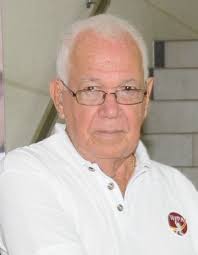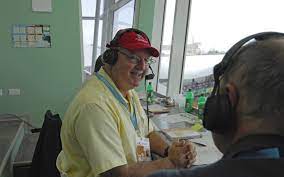By Joseph Reds Perreira
 While conducting my research on the brave men who presented ball by ball commentary to the Guyanese and Regional public, I reached out to a wide cross-section of people to be able to document the various personalities who provided important information while painting a word picture for listeners not at the same venue. I believe early commentary might have been done on the ZFY station just around the corner from Bourda on North Road, and later carried by Radio Demerara (Rediffusion owned) and the Guyana Broadcasting Service (GBS).
While conducting my research on the brave men who presented ball by ball commentary to the Guyanese and Regional public, I reached out to a wide cross-section of people to be able to document the various personalities who provided important information while painting a word picture for listeners not at the same venue. I believe early commentary might have been done on the ZFY station just around the corner from Bourda on North Road, and later carried by Radio Demerara (Rediffusion owned) and the Guyana Broadcasting Service (GBS).
My recollection of some of the early voices include Herman De Caries, Harry Cressall, Claude Viera, Kenny Wishart and Peter Bailey. Names like Brian Sadler, Norman McLean and Clyde Walcott were also part of the Radio Demerara team.
In 1968 when GBS came into operation yours truly along with Frank Bettencourt, Rocky Mann, Fred Wills, Stanley Moore and Cuthbert Monchoir. Others who followed included Sean Devers, Allan LaRose, Nayem Chan, Inderjeet Persaud, Matthew Kissoon, Keith Austin, Allan Brasillio, Clive Bacchus, Edwin Searaj, Imran Khan and John Ramsingh.
Some of the personalities who served as comments men were Ronnie Willock, Steve Comacho, Basil Butcher, Rodrick Lovell, Sydney Jackman, Germain Neblett, Travis Dowling, Steve Jacobs, Neil Barry, Clyde Butts, Mark
and Roger Harper.
I’ve always felt the cricket listening public was over-critical of those personalities who faced the microphone, as they had to deal with live radio describing play as it happened in a matter of seconds. The same applied to the comments personalities who on occasion had a little more time to analyze a dismissal or a good bowling or
batting performance, condition of the pitch and bowling changes. By contrast, the
Guyanese/Regional cricket writers returning to their desks at close of play would have adequate time to provide readers with a description of the days’ proceedings but not under the same time constraints of the spoken commentary on live radio.
To further improve the art of ball-by-ball commentary, regular opportunities must be provided by the radio stations in Guyana to sports commentators. On some occasions, it would be valuable to arrange for ball-by-ball broadcasts of weekend matches and where necessary schedule individuals to do ten-minute reports from
various grounds providing opportunities to be on-air on a regular basis, for all club events.
The cricket venues in my early days were Bourda, Everest, DCC, Hampton Court, Rose Hall , Albion, Enmore, Leonora, Uitvlugt, Blairmont, the Mental Hospital, McKenzie Sports Club, all the club grounds in Georgetown, Berbice and Essiquibo, and of late Providence. The cricket writers in the 60s and 70s were McDonald Dash,
Julian Mends, Rick Ferreira, Ceddi Wilshire, Bruser Thomas and Prior Jones.
Among the official Cricket Board Scorers were Ron Legall, Zandra DeFlorimonte and Rudolf Haynes. Ron Legall later became the Scorer for GBS Radio and reached the international level, scoring many Test
matches, ODIs and numerous first-class games.
On Radio Demerara at five to eight and “do not be late”, B L Crombie provided a 5-minute sports cast covering the major events of the day for well over 26 years. B L later became full-time on Radio Demerara after GBS was opened in October of 1968.
The reporters on radio were Zandra DeFlorimonte, Troy Peters, Claude David, Franklin Wilson, Chunya Huvel. Courtney Gonsalves reported on sport in Essiquibo and similar reports came from Berbice correspondents.
The T20 white ball game is changing the language of cricket which it is hoped will
not be used, when the commentators describe the 4-day first class format or the Test game. Listeners and viewers are now hearing pace off – pace on ( as if Fraklin Stephenson is totally forgotten as the man who created these deliveries), we go back to the descriptions Hard length, batting got heavy lifting- Match Up- Dug Out-
Change room(no mention of dressing room) – leg pole – off pale-grab(catch) bowler got 4 bullets left- bowler got two rocks to come- there are four soldiers in the covers, hit and a miss as well as stand and deliver!
Because of the excellent availability of stats on players a great deal is being provided by some commentators and although such information is in general is appreciated it must not get to the level of being too technical to eliminate 60-70% of viewers and listeners. In giving advice, some commentators tend to cross the line and are found to be coaching while on air. Others seem to forget that they are broadcasting to the
world and not about players only from their land of birth.
During the halcyon days of the conventional 5 Test series in the Caribbean, some of the top international voices who visited and worked included E.W . Swanton, Don Mosley, Trevor Bailey, Jonathan Angnew, Jeff Boycott, Allen McGuilvery, Jim Maxwell, Nevil Oliver, Harsha Bhogle, Dickie Rutnigar, Sunil Gavaskar, Berry
Sarbadhikari (1971 Indian Tour ) Allan Richards, Bryan Waddle, Gerald DeKock. It is also important to note some of the early West Indian journalists who covered the 1950 England Tour, such as Barbados’ E.L.C. Cozier ( Father of Tony Coizer) and Guyana’s Earnest Itel who also did the West Indies 1951 tour to Australia.
